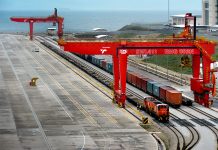
The post-Covid-19 container demand boom appears to have peaked, based on Drewry’s port throughput index, which showed a decline in April.
The Shanghai lockdown took its toll as volumes in the world’s busiest port fell 25% in April, compared with March.
The Drewry Global Port Throughput Index increased by 1.7% month-on-month to reach 141.1 points in April 2022, 1.5% below the 143.1 points recorded in April 2021.
“This is further evidence that the post-Covid demand boom appears to have run its course,” said Drewry.
North America recorded a 4.5% increase in port handling, with Oceania being the only other region in positive territory. Throughput in Asia (excluding China) was 4.1% lower year-on-year, with ports in this region quick to feel the impact of Chinese lockdowns on trade.
European volumes remained below 2021 levels, with the ongoing crisis in Ukraine driving steep rises in energy costs and consequentially impacting regional manufacturing and consumer demand.
In a commentary released on 11 July, Neil Dekker, a senior analyst at maritime credit reporting agency Infospectrum, said that there are warning signals for the container shipping market, both in the short and long term.
“There have been real signs of a decline in cargo growth during Q2 2022 compounded by the factory shutdowns and port congestions in China as well as normal seasonality. Current estimates of global cargo growth for 2022 range from about zero to 2% to 3% (down from 6% in 2021), with Maersk management now more negative about future growth,” said Dekker.
Average spot freight rates on the core Asia to North Europe trade have also contracted by about 20% to 30% since early December 2021, although these remain at record-high levels when compared to early 2020.
Rising charter and bunker costs present long-term risk factors, according to Dekker.
Noting that while some liner operators are managing costs by expanding their owned fleets, others have committed to long-term charters, Dekker said, “Companies that are more highly exposed to charters (at record-high rates) for the next three to five years (and this also includes Zim Integrated Shipping) will need to carefully manage operating costs.”
Martina Li
Asia Correspondent





